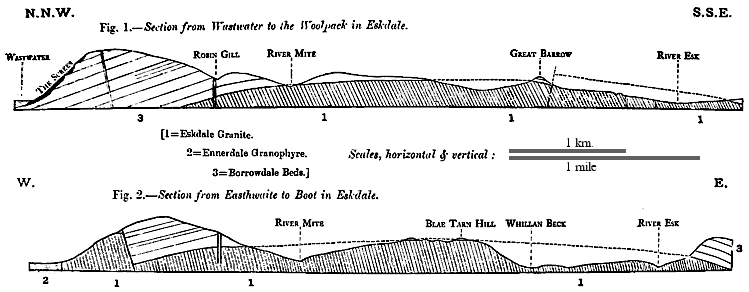

A.R. DWERRYHOUSE ON ESKDALE GRANITE
This is an extract from a paper titled "On Some Intrusive Rocks in the Neighbourhood of Eskdale (Cumberland)", by Arthur Richard Dwerryhouse D. Sc., F.G.S., published in the Quarterly Journal of the Geological Society, vol. lxv, February 1909. Other sections of the paper deal with the mineralogy and crystalline structure of the granite (with black-and-white microphotographs)
The granite is intrusive in the lavas and ashes of the Borrowdale Series, and its line of junction with these rocks is well seen at intervals along its north-western, northern, south-eastern, and eastern margins; but to the westward both the Borrowdale rocks and the granite are covered unconformably by the Trias (St. Bees Sandstone).
For a distance of about half a mile, from the foot of Wastwater to Easthwaite Farm, the granite is in contact with the Buttermere and Ennerdale Granophyre recently described by Mr. R.H. Rastall [Quart. Journ.Geol. Soc. vol. lxii (1906) pp. 253-73]. From the foot of Wastwater the boundary runs due south up the steep slope by Pens End on to the shoulder of Whin Rigg, the junction being for some distance a faulted one, and the fault-plane being occupied by a vein of ironstone. The line of fault cannot, however, be far from the edge of the intrusion, as the natural boundary comes in on the crest of the hill, and in several places on the slope the fine-grained marginal varieties of the granite, which will be more fully described hereafter, are to be seen.
The floor of Mitredale is occupied by the granite, and in Robin Gill, a tributary of the Mite, the junction of the granite and the Borrowdale rocks is seen dipping at a low angle northwards. The granite becomes increasingly finer in texture as the margin is approached, an undergoes at the same time a considerable change in chemical composition. The Borrowdale rocks are much altered, and in some places approach the condition of a mica-schist.
From Mitredale the line of junction passes along Black Gill over White Moss to Brown Band, and turns northwards by Acre Hows and Eskdale Moor to the shores of Burnmoor Tarn. It then crosses Hardrigg Gill at 1100 feet above O.D., the junction being visible in the small gorge at the head of the cascade, about 10 yards below the point where a small tributary joins the stream on its left bank. Close to the junction the granite is white with a greenish tinge, is extremely fine-grained, and contains 96.16 per cent of silica. Some 10 yards farther from the margin it assumes a pink colour, and is similar in texture to the finer specimens from Robin Gill. Specimens of the actual junction were collected, and a junction-breccia, consisting of fragments of Borrowdale lava in a granite-matrix, occurred as boulders in the bed of the stream.
